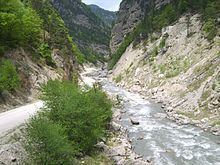River mouth Sunzha River Length 133 km Mouth Sunzha River | Basin size 2,060 km (800 sq mi) Basin area 2,060 km² Country Russia | |
 | ||
The Assa (Tsirtslovn-Tskhali, Russian: Асса, Цирцловн-Цхали, Georgian: ასა, Chechen: Iaьса-хи, Ingush: Эса-хий) is a right tributary of the Sunzha River in Georgia and Russia. It is located in Dusheti Municipality of Mtskheta-Mtianeti, Georgia; and in Dzheyrakhsky and Sunzhensky Districts of Ingushetia and in Sunzhensky and Achkhoy-Martanovsky Districts of Chechnya, Russia.
Contents
Map of r. Assa, Chechnya, Russia
Geography
It measures 133 kilometres (83 mi) long, and incorporates a drainage basin which is 2,060 square kilometres (800 sq mi). The basin includes the major part of Ingushetia, areas in the west of Chechnya, as well as minor areas in the north of Georgia. Within the river basin, more than 70% of the territory is subjected to avalanches.
The river's source is on the northern slopes of the Greater Caucasus in Khevsureti from where it flows north and crosses into Russia. The Assa accepts the Gulaykhi River from the right and flows through the Erzi Nature Reserve. North of the stanitsa of Nesterovskaya, the Assa turns east, crosses into Chechnya, flows through the stanitsa of Assinovskaya, and accepts the Fortanga from the right. The mouth of the Assa is at the locality of Zakan-Yurt. The principal tributary of the Assa is the Fortanga River (right).
The Assa and Terek Rivers also flow through the Republic of Ingushetia in a south to north direction. The Assa, Terek and Gulaykhi river valleys are known for their large complex of stone battle towers and dwellings, burial crypts, pagan sanctuaries, and Christian churches". The Ingushes culture of the North Caucasus, one of the ancient cultures, is well preserved here by the Dzhairakha-Assa state historical and architectural museum. The village of Alkhaste is situated on the river's left bank, while the rural locality of Samashki is located on the river's outskirts. The village of Alkun is split in two by the river; Lower Alkun is inhabited by Ingush, while Upper Alkun is inhabited by Orstkhoy.
The climate in the river valley is characterized as having a frequent drying effect which supports special microzones.
History
In the Middle Ages, a mine was located on the right bank, measuring 1 kilometre (0.6 mi) in length and 200 to 250 metres (660 to 820 ft) in width. Finds included an iron bar and working of native gold.
Though construction of a railway tunnel was envisaged from Georgia to Russia in the 1980s, including passage through the Assa River valley, construction was suspended a decade later.
Reservation
The upper reaches of the Assa River and the Armhi River have been combined into a natural reservation called the Jeyrakh-Assa Reservation, which has canyon valleys. Its historical importance is due to the medieval Christian Temple of 12th century and several other structures of bronze age (9th through 6th centuries BC), 300 towers of the 16th and 17th centuries which are habitable and where battles were fought, and 18 human habitats including 200 vaults dated to the same era. For these historical reasons, the Jeyrakh-Assa Reservation has been proposed to be inscribed as a UNESCO World Heritage Site.
